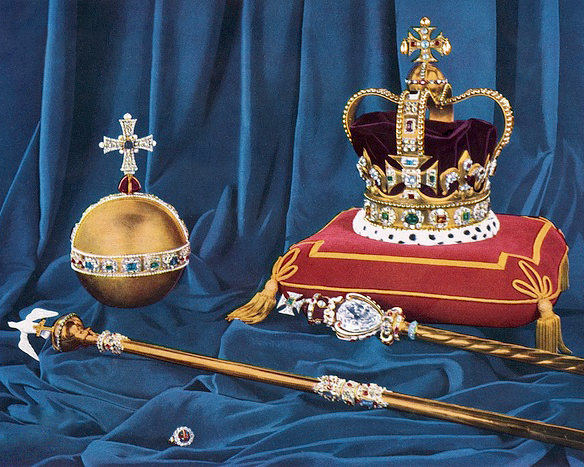
It’s one of the oldest and storied item in the Crown Jewels, the Sovereign’s Orb.
Created in 1661 by Sir Robert Vyner for Charles II’s coronation, the orb is a hollow gold sphere with a cross on top. It symbolizes the monarch’s Christian sovereignty and their position as head of the Church of England.
The orb weighs 1.32 kg (3lbs.) and is bejeweled with bands of nine emeralds, 18 rubies, nine sapphires and 365 diamonds. 375 pearls border the jewel bands that divide the orb into thirds, representing the three continents known in medieval times. The cross sits atop an amethyst and is bejeweled with a sapphire, an emerald, diamonds and pearls. Of all the 17th century Crown Jewels, the orb retains the most of its original jewels.
Embed from Getty ImagesCharles III will receive the orb in his right hand during the investiture portion of the coronation. The Archbishop of Canterbury will hand it to him, saying, “Receive this orb set under the cross and remember that the whole world is subject to the Power and Empire of Christ our Redeemer.” It will the be set on the altar, so he can hold the sceptres. Then the Saint Edward’s Crown will be placed on Charles’s head. When he processes out of Westminster Abbey, King Charles III will carry the Sovereign’s Orb in his left hand.
Orbs have been in use for centuries in many cultures. In the British monarchy, it is believed Henry VIII is the first monarch to incorporate an orb in his coronation. Elizabeth I’s coronation portrait shows her holding an orb in her left hand. This Sovereign’s Orb is the current version. Previous orbs and Crown Jewels were destroyed during the English Civil War.
Embed from Getty ImagesThere are two orbs in the Royal Collection. The first one is the Sovereign’s and the second one is Queen Mary II’s Orb. This one was created in 1689 for the coronation of Queen Mary II. When she was crowned with her consort husband, William III, many of the main pieces of regalia were used for her husband, even thought they claimed their joint power through her inheritance. And so, she needed an orb. Mary and William are the only joint English rulers. The second orb was used only one other time. When Queen Victoria died, it was placed on her coffin with the Sovereign’s Orb. It is thought to represent that she was Queen and Empress of India.
When not in use for funerals or coronations, the Sovereign’s Orb is on display at the Tower of London with the collection of Crown Jewels.

